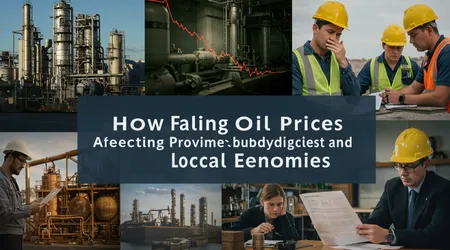How Falling Oil Prices Are Affecting Provincial Budgets and Local Economies

In 2025, falling oil prices cast a long shadow over Canada’s economic landscape, particularly in oil-dependent provinces like Alberta, Saskatchewan, and Newfoundland and Labrador.
Global crude oil prices, with Brent crude dipping to $65.58 per barrel in April 2025, have triggered fiscal tremors, forcing provincial governments to rethink budgets and local communities to brace for economic strain.
This isn’t just a story of numbers it’s about people, businesses, and governments navigating a volatile market.
From Calgary’s oilfield service firms to rural Saskatchewan farmers, the ripple effects of falling oil prices demand attention.
Why are these declines hitting so hard, and what can Canada do to adapt?
This article dives into the financial fallout, regional impacts, and potential paths forward, blending hard data with real-world stories.
The global oil market’s downward spiral, driven by trade tensions and OPEC+ production hikes, has slashed provincial revenues.
Alberta’s 2025 budget, for instance, hinges on West Texas Intermediate (WTI) at $68 per barrel a figure now $5 below current levels.
Every $1 drop in WTI costs Alberta’s treasury $750 million annually, a stark reminder of oil’s fiscal weight. Meanwhile, local economies face job cuts and reduced investment, threatening small businesses and household incomes.
Yet, there’s a silver lining: lower fuel costs could ease consumer burdens, and provinces have a chance to diversify.
Let’s explore how falling oil prices are reshaping Canada’s financial and social fabric, with practical examples and forward-looking insights.
The Fiscal Squeeze: Provincial Budgets Under Pressure
Alberta’s economy, a powerhouse of Canada’s oil sector, reels as falling oil prices erode its fiscal foundation.
The province’s 2025 budget projected a $5.2 billion deficit, banking on stable oil revenues. With WTI now at $63, the shortfall could widen significantly.
Each dollar drop in oil prices slashes $750 million from Alberta’s coffers, forcing tough choices cut services or dip into reserves?
The government’s tax cut plan, offering an 8% rate on the first $60,000 of income, may face delays if revenues keep sliding.
Saskatchewan, another oil-heavy province, feels the pinch too. Its 2025 budget aimed for a $12 million surplus, but falling oil prices threaten this delicate balance.
Oil royalties, a key revenue stream, are projected to shrink, potentially pushing the province into a deficit. Public sector investments, like infrastructure, may face cuts, stalling growth.
The province’s low debt burden offers some wiggle room, but prolonged low prices could strain even this advantage.
++ The Shift Toward Green Investments in Canadian Financial Markets
Newfoundland and Labrador’s budget, reliant on offshore oil royalties for 15% of revenue, faces a grim outlook.
The province projected Brent at $74, but with prices at $63, deficits could balloon beyond the forecasted $372 million.
Projects like Bay du Nord, already on hold, may stall further, dimming economic hopes. These provinces, tethered to oil, must now navigate a fiscal storm with creativity and caution.

Local Economies: The Human Cost of Declining Revenues
Beyond budget ledgers, falling oil prices hit local economies where it hurts jobs and livelihoods.
In Fort McMurray, Alberta, oilfield worker Jane Carter, 38, faces uncertainty. Her employer, a drilling contractor, cut hours due to reduced capital spending.
“We’re tightening belts, skipping vacations,” she says. Small businesses, like local diners, see fewer customers as workers leave.
Also read: Minimum Wage in Canada in 2025: What Has Changed?
The ripple effect is clear: less income, less spending, weaker economies.
Saskatchewan’s rural communities, like Estevan, feel similar pain. Farmer Mike Larson, 45, relies on oilfield leases for extra income.
With falling oil prices, companies are scaling back, and his lease payments have dried up. “It’s like losing half your crop,” he says, an analogy for the sudden income drop.
Retail and service sectors, from hardware stores to cafes, report declining sales as oil workers tighten budgets.
Read more: What’s happening in Canada today? Top news and updates
Newfoundland’s coastal towns, like St. John’s, face a double blow. Offshore oil projects, a lifeline for local jobs, stall as falling oil prices deter investment.
Fishermen, already struggling, see fuel costs drop a small win but it’s dwarfed by reduced oil-related work.
These stories show how oil price declines cascade through communities, demanding resilience and adaptation.
The Global Context: Why Oil Prices Are Tanking
Understanding falling oil prices requires a global lens. In April 2025, Brent crude fell 13% to $65.58, driven by trade wars and OPEC+ decisions.
President Trump’s 10% tariffs on imports, announced April 2, sparked fears of a global recession, curbing oil demand.
China’s retaliatory 34% tariffs further clouded the outlook, slashing demand forecasts by 0.4 million barrels per day.
OPEC+’s move to unwind production cuts, starting in May, flooded markets with supply. Non-OPEC countries, like Canada and Brazil, also boosted output, creating a surplus.
Goldman Sachs predicts Brent will average $68 in 2025, but persistent trade tensions could push it lower.
This global oversupply, coupled with economic uncertainty, keeps prices volatile, hitting Canada’s oil exporters hard.
Canada’s vulnerability stems from its reliance on U.S. markets 80% of oil exports go south. Trump’s tariff threats, though not yet applied to Canadian oil, loom large.
If imposed, they could devastate Alberta’s oil patch, raising U.S. pump prices and costing Canadian jobs. Navigating this global maze requires strategic trade policies and market diversification.
Opportunities Amid the Chaos: Adapting to Low Prices
While falling oil prices sting, they also spark opportunity. Lower fuel costs ease consumer burdens, boosting disposable income.
In Alberta, a family saving $20 weekly on gas might spend more at local shops, softening economic blows.
Provinces can leverage this to stimulate non-oil sectors, like tech or renewables, reducing oil dependency.
Diversification is key. Alberta’s $6.9 million investment in rural policing and $330 million in health projects show a shift toward broader economic pillars.
Saskatchewan’s construction sector, buoyed by public spending, could absorb oil job losses. Newfoundland’s focus on fisheries and tourism, supported by lower fuel costs, offers a buffer against oil volatility.
Policy innovation matters too. Alberta’s fiscal framework, introduced in 2023, builds contingencies for price swings, offering a model for others.
Provinces could explore carbon capture or green energy, aligning with global trends. By seizing these opportunities, Canada can turn a crisis into a catalyst for sustainable growth.
Table: Provincial Budget Impacts from Falling Oil Prices (2025 Projections)
| Province | Budgeted Oil Price (USD) | Current Oil Price (USD) | Estimated Revenue Loss | Projected Deficit |
|---|---|---|---|---|
| Alberta | $68 (WTI) | $63 (WTI) | $3.75B (for $5 drop) | $5.2B+ |
| Saskatchewan | $70 (WTI) | $63 (WTI) | $200M (est.) | $12M surplus at risk |
| Newfoundland & Labrador | $74 (Brent) | $63 (Brent) | $300M (est.) | $372M+ |
The Long-Term Outlook: Preparing for a Post-Oil Future
Looking ahead, falling oil prices signal a broader shift. Global oil demand is projected to peak by 2030, driven by electric vehicles and net-zero goals.
Canada, with 80% of its oil exported, faces risks as markets shrink. Newfoundland’s high-cost offshore projects, like Bay du Nord, may become unviable, underscoring the need for economic reinvention.
Provinces must invest in education and skills training now. Alberta’s tech sector, growing in Calgary, could absorb oil workers with retraining.
Saskatchewan’s agricultural innovation, like precision farming, offers stable jobs.
Newfoundland’s renewable energy potential, like offshore wind, could replace oil revenues. These shifts require bold, proactive policies.
Community resilience is equally vital. Local governments should foster small business incubators, as seen in Edmonton’s startup hubs, to diversify economies.
Federal support, like aligned fiscal policies, can ease the transition. Canada’s oil era isn’t over, but preparing for a post-oil future is non-negotiable. The time to act is now.
Conclusion: A Call to Adapt and Innovate
The impact of falling oil prices in 2025 is a wake-up call for Canada’s oil-dependent provinces.
Alberta, Saskatchewan, and Newfoundland face budget deficits, job losses, and economic uncertainty, with Alberta alone risking a $3.75 billion revenue hit.
Yet, this crisis isn’t just about survival it’s about transformation. Lower fuel costs offer consumers relief, and provinces have a chance to pivot toward diversified economies.
From Jane Carter’s job struggles in Fort McMurray to Mike Larson’s lease losses in Estevan, the human toll is real, but so is the potential for renewal.
Canada’s strength lies in its ability to adapt. By investing in new industries, retraining workers, and building fiscal buffers, provinces can weather this storm and emerge stronger.
The global shift away from oil is inevitable, but Canada’s response rooted in innovation and resilience can shape a prosperous future.
Will we seize this moment to redefine our economic destiny? The answer lies in our actions today.
Frequently Asked Questions
1. How do falling oil prices affect my personal finances?
Lower oil prices reduce fuel costs, saving you money at the pump potentially $15-$20 weekly. However, in oil-dependent regions, job cuts may reduce local spending, impacting small businesses you rely on.
2. Which provinces are most affected by falling oil prices?
Alberta, Saskatchewan, and Newfoundland and Labrador face the biggest hits due to their reliance on oil royalties. Alberta’s budget, for example, loses $750 million per $1 drop in WTI.
3. Can falling oil prices benefit local economies?
Yes, cheaper fuel boosts consumer spending and lowers costs for industries like transportation. Provinces can redirect savings to non-oil sectors, like tech or tourism, fostering economic diversity.
4. What can provinces do to mitigate the impact of low oil prices?
They can diversify economies (e.g., Alberta’s tech investments), build fiscal reserves, and retrain workers for emerging industries like renewables. Long-term planning is critical.
5. Will oil prices recover soon?
Goldman Sachs forecasts Brent at $68 in 2025, but trade wars and oversupply add uncertainty. Recovery depends on global demand and geopolitical stability, making diversification urgent.
